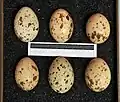| Spotted crake | |
|---|---|
.jpg.webp) | |
| Scientific classification | |
| Domain: | Eukaryota |
| Kingdom: | Animalia |
| Phylum: | Chordata |
| Class: | Aves |
| Order: | Gruiformes |
| Family: | Rallidae |
| Genus: | Porzana |
| Species: | P. porzana |
| Binomial name | |
| Porzana porzana (Linnaeus, 1766) | |
 | |
| Range of P. porzana
Breeding Passage Non-breeding | |
| Synonyms | |
|
Ortygometra porzana (Linnaeus, 1766) Rallus porzana Linnaeus, 1766 | |
The spotted crake (Porzana porzana) is a small waterbird of the family Rallidae. The scientific name is derived from Venetian terms for small rails.[2]
The spotted crake's breeding habitat is marshes and sedge beds across temperate Europe into western Asia. They nest in a dry location in marsh vegetation, laying 6–15 eggs. This species is migratory, wintering in Africa and Pakistan.
At 19–22.5 cm (7.5–8.9 in) length, spotted crakes are slightly smaller than water rails, from which they are readily distinguished by the short straight bill, yellow with a red base. Adults have mainly brown upperparts and blue-grey breast, with dark barring and white spots on the flanks. They have green legs with long toes, and a short tail which is buff underneath.
Immature spotted crakes are similar, but the blue-grey is replaced by brown. The downy chicks are black, as with all rails.
The only confusion species is the sora, a rare vagrant from North America. However, that species lacks the breast spotting and has an unstreaked crown stripe.
These birds probe with their bill in mud or shallow water, also picking up food by sight. They mainly eat insects and aquatic animals.
Spotted crakes are very secretive in the breeding season, and are then mostly heard rather than seen. They are then noisy birds, with a distinctive repetitive whiplash-like hwuit, hwuit call. They can be easier to see on migration.
The spotted crake is one of the species to which the Agreement on the Conservation of African-Eurasian Migratory Waterbirds (AEWA) applies. The Western European population has declined in recent decades, and the species is now a very rare breeding bird in Great Britain.[3]
Gallery
 Eggs at Museum Wiesbaden, Germany
Eggs at Museum Wiesbaden, Germany.jpg.webp) Immature
Immature_(6830876880).jpg.webp) Adult
Adult In art
In art ID composite
ID composite
References
- ↑ BirdLife International (2016). "Porzana porzana". IUCN Red List of Threatened Species. 2016: e.T22692676A86160125. doi:10.2305/IUCN.UK.2016-3.RLTS.T22692676A86160125.en. Retrieved 12 November 2021.
- ↑ Jobling, James A (2010). The Helm Dictionary of Scientific Bird Names. London: Christopher Helm. p. 315. ISBN 978-1-4081-2501-4.
- ↑ Francis, I.; Stroud, D.A. (2006). "Spotted Crakes "Porzana Porzana" breeding in the UK – a history and evaluation of current status". In Boere. G.C.; Galbraith, C.A.; Stroud, D.A. (eds.). Waterbirds around the world. Edinburgh: The Stationery Office Limited. pp. 491–492.
External links
- Spotted crake species text in The Atlas of Southern African Birds.
- BirdLife species factsheet for Porzana porzana
- Feathers of Spotted crake (Porzana porzana)
- "Porzana porzana". Avibase.
- "Spotted crake media". Internet Bird Collection.
- Spotted crake photo gallery at VIREO (Drexel University)
- Interactive range map of Porzana porzana at IUCN Red List maps
- Audio recordings of Spotted crake on Xeno-canto.
